Visit to Lotusland, part 2: House Garden with cactus and euphorbia
It might easily have been all Italian cypress, boxwood, and roses. But Lotusland‘s Madame Ganna Walska, self-proclaimed “enemy of the ordinary,” didn’t settle for the expected. One of the first changes she made upon taking up residence in 1941 at the Santa Barbara, CA, estate was to rip out the existing foundation plants and replace them with an otherworldly garden of cactus and euphorbia. Who could possibly envision this for their front entry? I’ll tell you who. Someone who delighted in surprise and drama, and who had a deep appreciation for the weirdly wonderful.
Do you?
Weeping Euphorbia ingens droops like melted wax on a guttered candle.
I could never describe their effect better than Gerhard Bock at Bamboo, Succulents & More, who visited in April and wrote:
“I remember these weeping Euphorbia ingens from the very first photo of Lotusland I ever saw, but the dramatic effect of their monstrous presence is even more pronounced when you stand in front of them. These aren’t ornamental plants designed to beautify your garden; they are extraterrestrial life forms come to Earth to keep an eye on us.”
I love the soft, chalky colors of house and plants in this doorway vignette. I didn’t get IDs for most of the plants I saw. I think this is a euphorbia too, though at first I mistook it for a fencepost cactus. It really is amazing how similar euphorbias and cacti can look, although their origins are half a world apart, cacti being native to the New World, euphorbias to the Old.
Those soft colors are accented with the black-maroon drama of Aeonium ‘Zwartkop’.
Argentine saguaro (I think) towers over a mass of golden barrel cactus — like a quilting bee’s worth of pincushions strewn across the ground.
I find golden barrels irresistible for their beach ball shape and lemon-lime coloring. Seeing so many planted together — hundreds, I expect — was awe inspiring.
No lawn here! Walska went for a spiny swath of columnar cactus instead. Don’t the smaller ones in front remind you of sock puppets?
Directly across from the house, a strange, spiny forest towers overhead and offers a deeply shaded, fairy-tale like hideaway beneath its canopy.
These are dragon trees, Dracaena draco, a relative of the common houseplant grown to prehistoric size under the Santa Barbara sun.
These handsome finials invite you to explore the Dracaena underworld…
…although the tiled wall’s detailing, including this fanciful dragon fountain, tempted us to stay in the sunlight.
Another aeonium sprawls atop the wall.
Equally dramatic was this copper tillandsia “tree” along the side of the house.
I’ve gone backwards in my post, starting with the drama of the house rather than with the approach drive, which is equally amazing, not just for the massing of unusual plants but for the cleverness of the overall planting scheme: one side of the driveway is planted with cacti, native to the Americas; the other side is planted with lookalike succulent euphorbias, native to Old World locales like Madagascar and South Africa. Pictured here is the cactus side of the drive.
And this is the euphorbia side. Evolving separately half a world apart, cactus and euphorbias developed similarly to adapt to extreme heat and aridity: tall, columnar forms that reduce horizontal exposure to the sun; small leaves, if any, that slow water loss; spines for defense against browsing animals; and water-retaining bodies.
It’s a perfect example of convergent evolution. As you approach the house, you’re walking the dividing line between New World and Old World, with plants on either side that are long-distant cousins.
These somewhat resemble golden barrel cactus, but I think they may be a type of euphorbia. Beautiful, aren’t they? (If anyone knows these plants well enough to supply an ID, please feel free.) Update: Thanks to Jenny Stocker for the ID — balloon cactus, Notocactus magnificus — and for pointing out that euphorbias tend not to have dramatic blooms like this, but cacti do.
I love the textures and contrasting forms in this vignette, plus that rosy cap on the columns (again, cactus or euphorbia?).
A closer look — fascinating.
I believe this is Agave gypsophila in flower, its bloom spike arching over the path that leads (behind us) down to the famous abalone-edged pool.
Next up: The aloe pool, Blue Garden, and Bromeliad Garden. For a look back at my introductory post about the Theatre Garden, lotus pond, and Japanese Garden, click here.
All material © 2006-2013 by Pam Penick for Digging. Unauthorized reproduction prohibited.


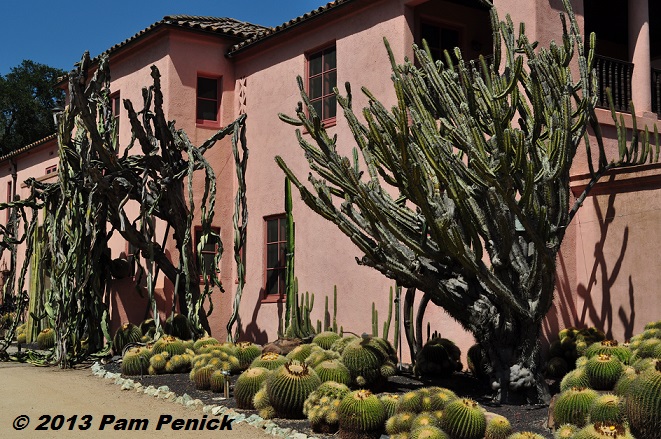
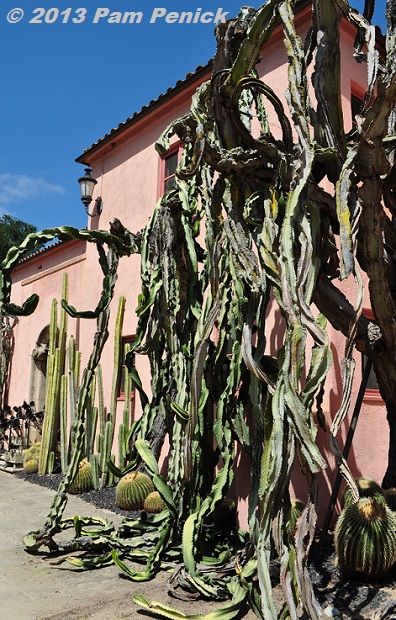
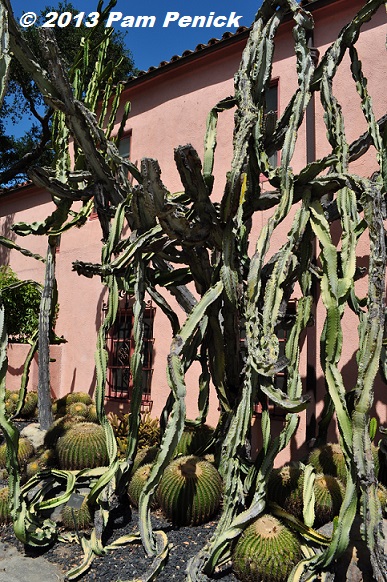
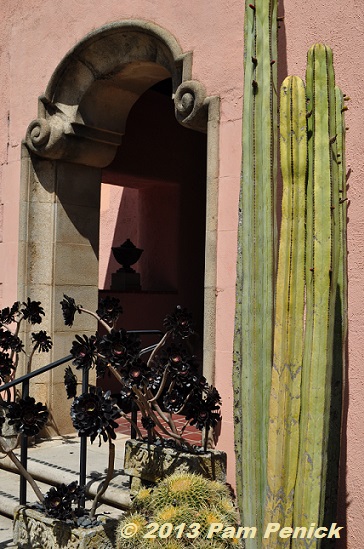
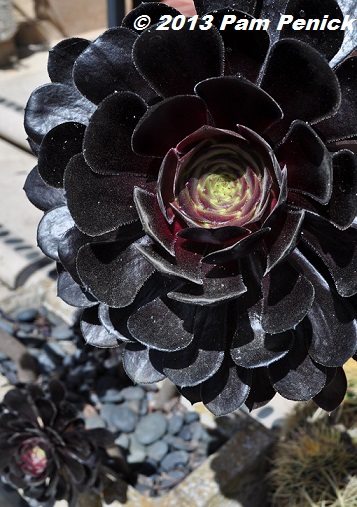
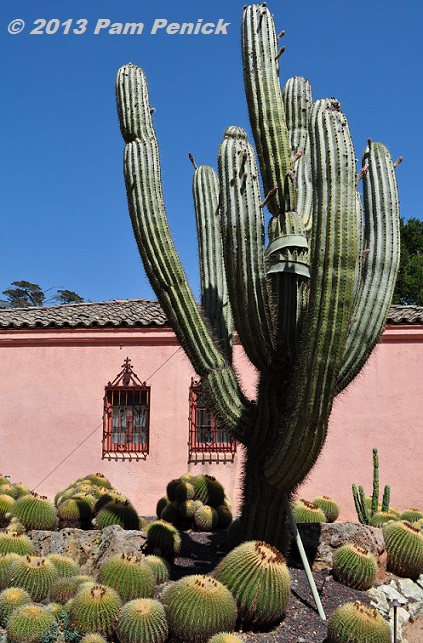
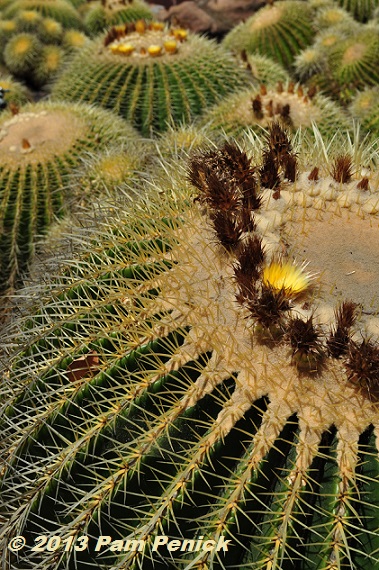
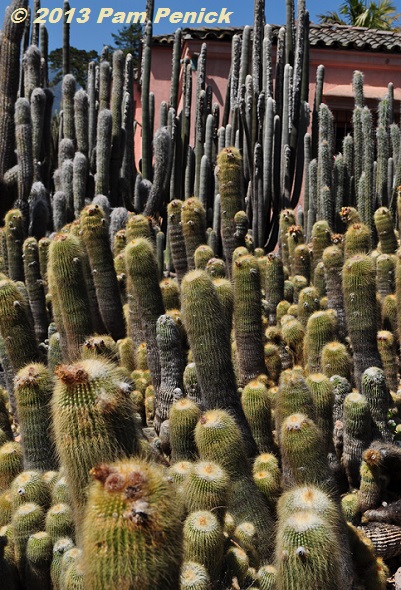
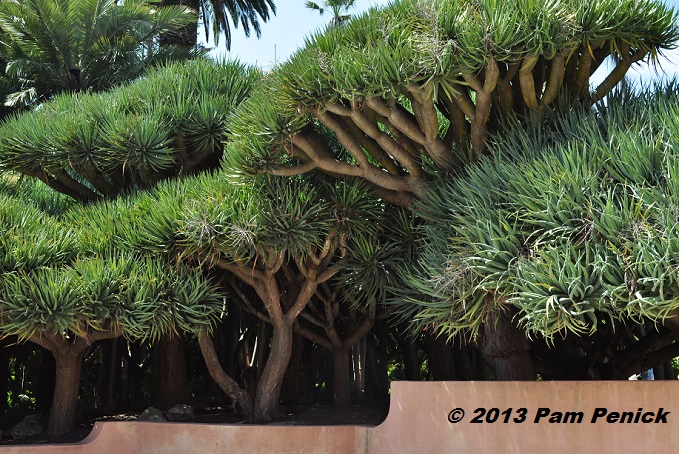
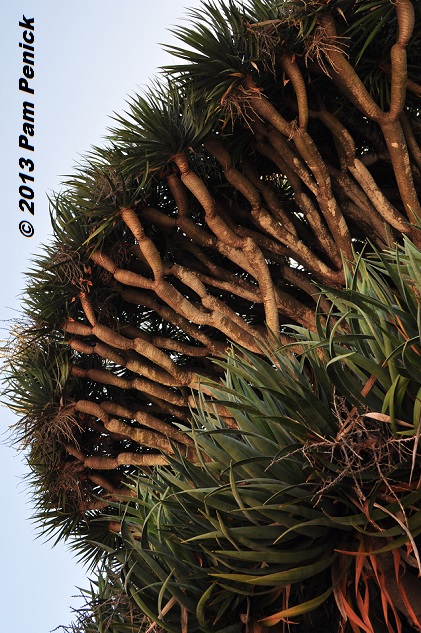
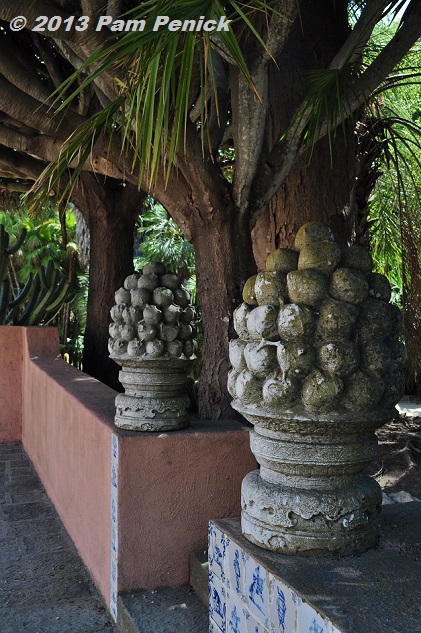
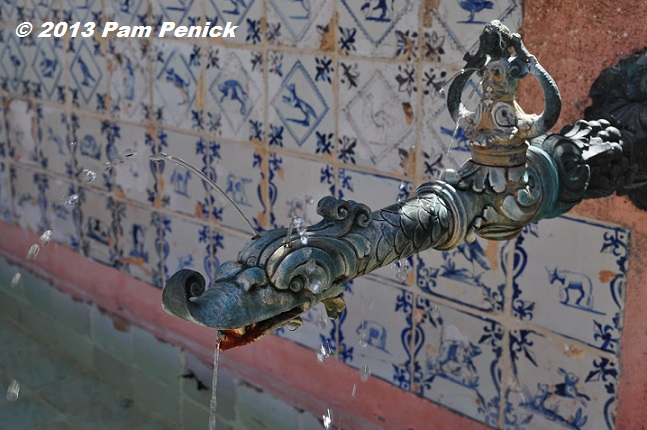
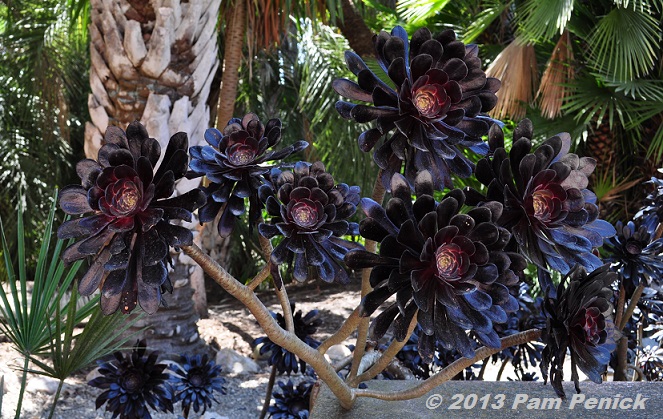
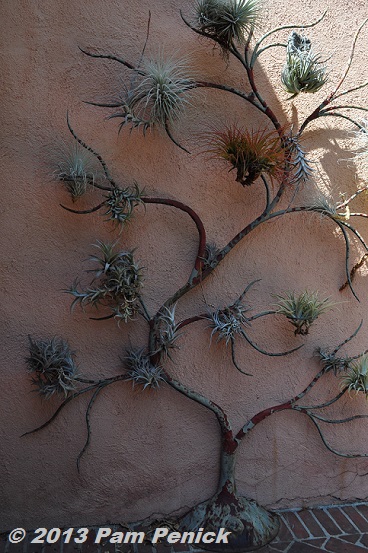
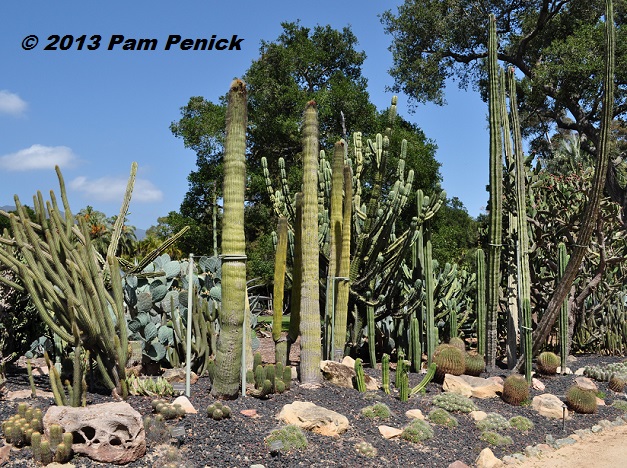
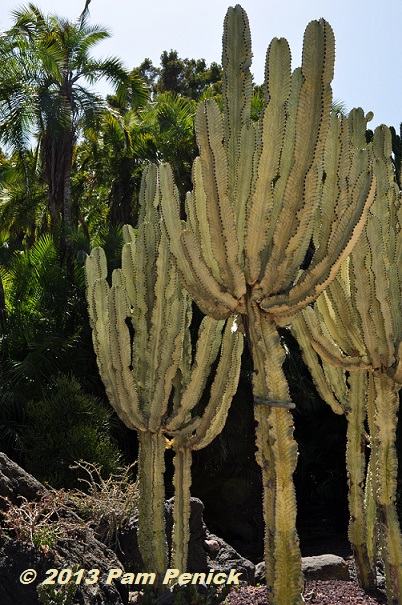
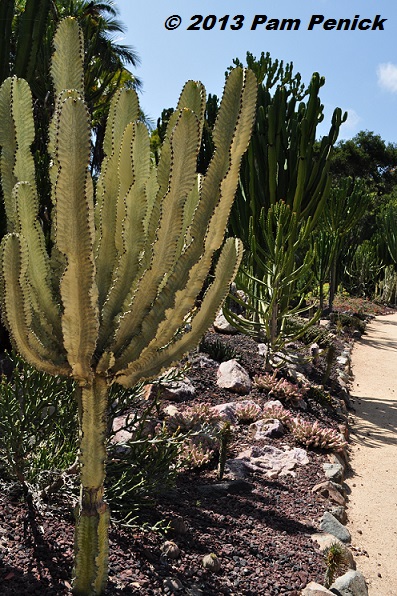
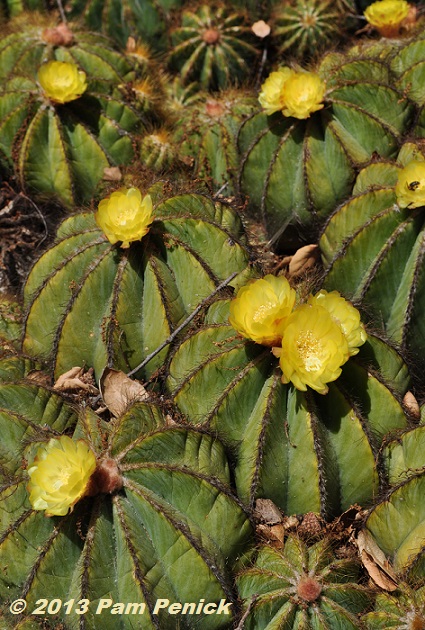
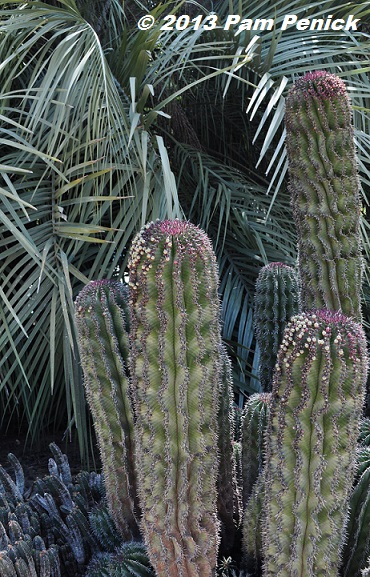
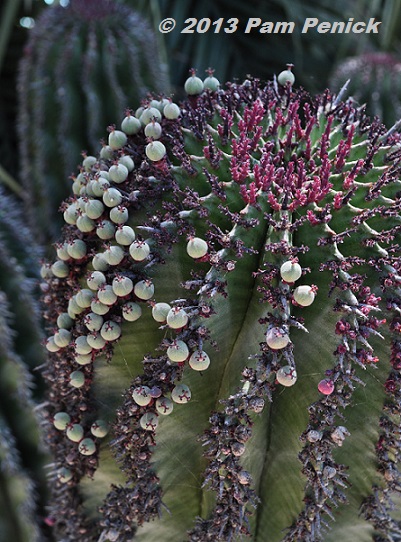
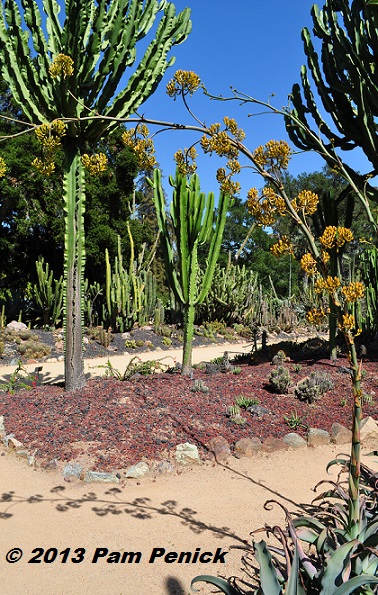
Even though I was just there, your photos make me want to go again. In my experience, Lotusland is completely unique.
I love your close-up of that columnar euphorbia!
I need to go again too, Gerhard. My visit wasn’t nearly long enough to see everything. —Pam
It’s an amazing place! I enjoyed your comparisons with the new and old world in photos.
It is amazing, Shirley, and sure to pique the interest of any gardener who appreciates foliage. —Pam
I would love to know how they weed around so many closely-spaced barrel cactus. That’s clearly not a task for the faint of heart!
Those dragon trees are fabulous!
Aren’t they? Kind of creepy too, we thought. As for the weeding, yes, it must be quite a job. But I bet truly arid climates like Santa Barbara, which receives only 15 inches of rain a year, have less of a weed problem than we do here in Austin. —Pam
Fantastic photos! Will dragon trees grow in Austin? I would love to try.
Only if you live where it never freezes, Melody. In other words, not Austin or any part of Texas. —Pam
I am in love with that first photo. I saw it on my “Reader” and couldn’t wait to see the rest. Beautiful job! What an awesome garden. Being from Phoenix, I know a cactus garden like that doesn’t grow overnight.
You’re right, Laura. This garden must have been a long time in the making. I’m glad you’re enjoying the tour! —Pam
Very interesting gardens with very unusual plants. Too bad you were not able to spend more time there.
Ah, don’t I know it. Still I have at least two more posts of pictures to come. —Pam
Amazing collection of weird and wonderfuls. The dragon trees are really stunning. The round cactus with yellow flowers is, I believe, called the balloon cactus, Notocactus magnificus. I have one that just flowered, with a top-knot of yellow flowers, following the rain. The next one is an euphorb. The euphorbs as far as I have seen all have rather tiny insignificant flowers. Those little white balls must be the fruits.
Thanks for the ID of the balloon cactus, Jenny, and for the info about cactus versus euphorbia flowers. —Pam
This is all so fascinating. I had no idea euphorbia could look like that–thanks for the ecology lesson!
I was fascinated to learn about the differences between cactus and euphorbs too, Heather. This garden was full of interesting tidbits like that. —Pam
Wonderful photos Pam…man I can’t wait to go back!
Me too, Loree! —Pam
Yes! I love weird. Makes the world (and gardens) much more interesting. I covet that dragon fountain. It goes well with the dragon trees.
Lotusland was full of clever touches like that, Sandy. It reminded me of Chanticleer in that regard — that sense of playfulness. —Pam
Magnificent!
Glad you’re enjoying the virtual tour, Heather. —Pam
Simply amazing!
I love those Dragon Trees, too. Too bad they won’t live here.
Yes, although sometimes I think if you lived where you could grow everything, the world would seem a little smaller and less magical, so maybe it’s all for the best. 🙂 —Pam